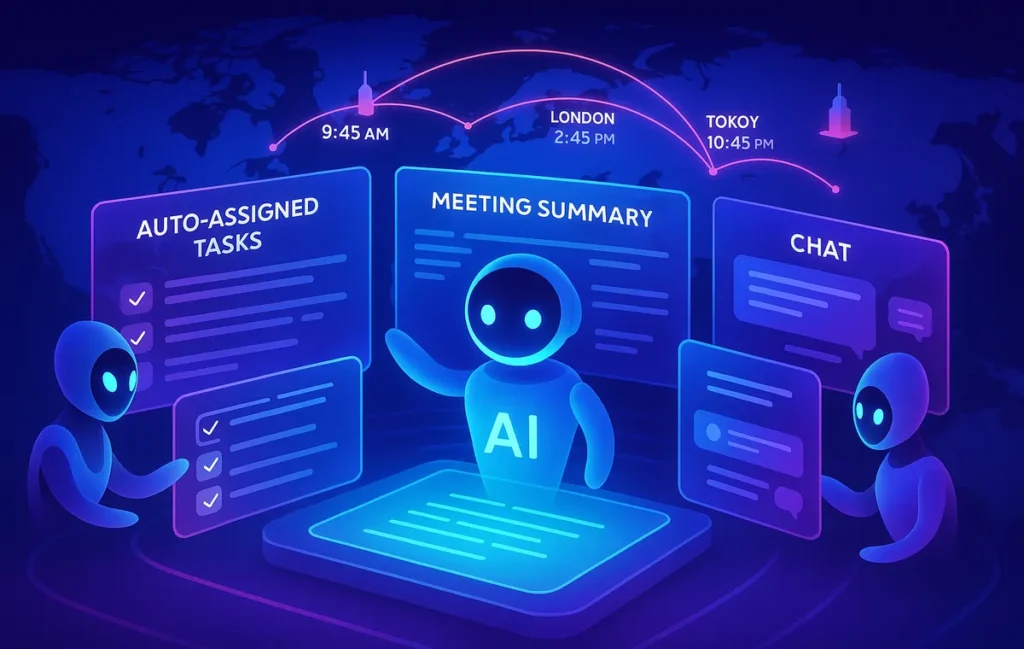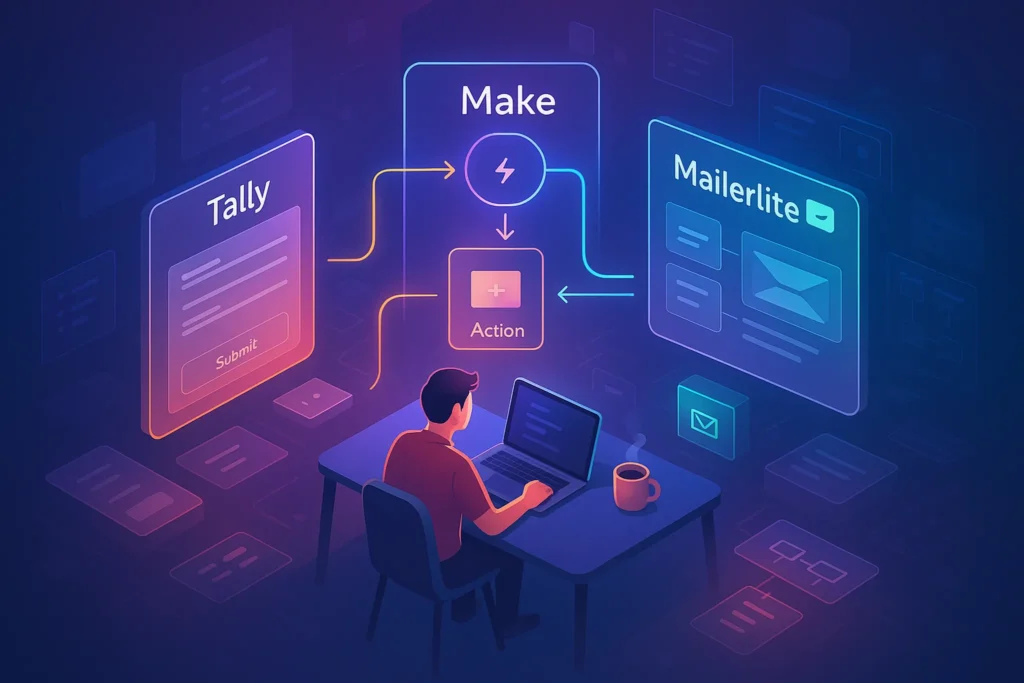🌍 Why Remote Teams Need AI Automation in 2025
Remote teams live in a paradox: more freedom but also more coordination headaches. Managing projects across time zones, juggling endless notifications, and ensuring tasks don’t fall through the cracks can drain productivity. That’s where AI task automation tools step in.
Instead of manually assigning tasks, chasing updates, or moving files between platforms, AI-driven tools automate these workflows. A survey from WorkLab in early 2025 found that teams using AI automation saved an average of 12 hours per week per employee. That’s the difference between working late nights and hitting deadlines without stress.
If you’ve already explored Best Workflow Automation Tools for Solopreneurs & Remote Teams, you know how critical automation is. But the leap to AI means these systems don’t just follow rules—they learn and adapt.
💡 Nerd Tip: For remote teams, AI automation isn’t a luxury. It’s the glue that holds distributed work together.
🛠️ Core Functions of AI Task Automation Tools
Modern automation goes far beyond “if this, then that.” AI-driven platforms can now:
-
Auto-assign tasks based on workload, timezone, and past performance.
-
Summarize meetings into actionable task lists using natural language processing.
-
Predict bottlenecks by analyzing project velocity and suggesting course corrections.
-
Integrate seamlessly across project management, communication, and cloud storage apps.
For example, AI assistants can pull tasks from Slack conversations, prioritize them, and send reminders to the right people at the right time. Tools that blend automation with collaboration—like the ones we reviewed in Best AI Tools for Remote Team Collaboration—are becoming indispensable for hybrid and global teams.
🎨 How AI Automation Changes Remote Collaboration
Before AI, task automation was rigid. Set a trigger, define an action, and hope nothing changes. But remote teams thrive in fluid environments, where priorities shift daily.
In 2025, AI-powered automation tools adjust in real time. If a designer in London misses a deadline, the AI reallocates tasks to teammates in Toronto or Singapore. If a client changes scope mid-project, the tool reprioritizes deliverables without requiring hours of manual adjustments.
An X user described it perfectly:
“Our AI tool literally felt like a project manager—rescheduling standups when someone was OOO and updating Asana without us lifting a finger.”
💡 Nerd Tip: Don’t think of AI automation as replacing managers—it amplifies them by handling repetitive adjustments, freeing humans for strategy.
📊 Mini-Comparison: Leading AI Task Automation Platforms
| Tool | Best For | Strengths | Potential Drawback |
|---|---|---|---|
| Zapier AI | General automation | Huge app library, AI-powered task suggestions | Can get pricey at scale |
| n8n + AI | Technical remote teams | Open-source, customizable, supports AI plugins | Steeper learning curve |
| Notion AI + Automations | Knowledge-driven teams | Embeds tasks into docs, generates summaries | Limited for complex workflows |
| HARPA AI | Web-first teams | Automates web tasks, scraping, and reporting | Less suited for deep PM integration |
Each tool balances flexibility and ease of use differently. As explored in How AI Assistants Can Handle Your Daily Tasks, the smartest approach is blending simple rule-based flows with adaptive AI modules.
📅 Remote Teams Across Time Zones: A Perfect Fit
One of the toughest challenges in distributed work is time zones. Managers often juggle asynchronous communication, wondering if teammates saw critical updates.
AI automation reduces that stress. For example, an automation can collect status updates from team members in Asia overnight, summarize them, and deliver a morning digest to U.S. colleagues before they even log in. Tools with scheduling intelligence also delay notifications until working hours in the recipient’s timezone.
This aligns perfectly with strategies shared in Pro Tips for Managing Remote Teams Across Time Zones. Instead of micromanaging when everyone is online, AI ensures the right information flows at the right time.
💡 Nerd Tip: Respecting time zones builds trust. Automation that delivers updates asynchronously keeps teams in sync without burning them out.
🧩 Real-Life Automation Wins
It’s easy to talk about features—but results tell the real story.
Take GlobeTech, a fully remote startup spanning four continents. Before automation, project managers manually compiled updates, wasting 10–12 hours weekly. After adopting an AI-driven workflow platform, the tool generated meeting notes, assigned tasks automatically, and flagged overdue items. Productivity reports showed a 15% increase in project completion rates within two months.
On a smaller scale, Maya, a freelance project coordinator, connected Slack, Google Drive, and Trello with Zapier AI. Her words on X were blunt:
“I stopped being a human copy-paste machine. The AI now moves files, updates cards, and even DMs my clients automatically. Feels like cheating—but in the best way.”
Stories like these highlight why AI automation is becoming the backbone of remote teamwork.
⚡ Ready to Build Smarter Workflows?
Explore AI workflow builders like HARPA AI, Zapier AI, and n8n plugins. Start automating in minutes—no coding, just creativity.
🔮 Future of AI Task Automation for Remote Teams
Looking ahead, AI automation will evolve from “helpful assistant” to “strategic collaborator.” Expect tools that:
-
Proactively suggest workflows before you ask, based on patterns in your team’s activity.
-
Auto-generate reports that not only track tasks but also recommend optimizations.
-
Blend with communication tools, where AI agents join meetings, take notes, and assign tasks autonomously.
This future is already visible. In pilots, AI copilots have cut meeting times by 20% simply by reducing redundant discussions. For remote teams, that’s hours saved weekly, feeding directly into productivity.
💡 Nerd Tip: Early adopters of AI automation often report not just time savings but reduced stress—because clarity is automated too.
⚖️ Pros & Cons of Top AI Automation Tools
No tool is flawless, and choosing wisely means weighing strengths against limitations.
Zapier AI stands out for its vast integration library, which connects thousands of apps. It’s perfect for non-technical teams that want fast results. The trade-off is cost—scaling beyond a few workflows quickly becomes expensive.
n8n with AI plugins appeals to technical teams who want flexibility. Being open-source, it allows deep customization and even on-premise setups. But the learning curve is steep, and smaller teams may struggle to dedicate resources for setup.
Notion AI Automations shine for knowledge-driven teams. Tasks live inside documents, meeting notes turn into to-do lists automatically, and summaries are generated on the fly. Yet, Notion’s automation is still limited when compared to dedicated platforms, making it better for internal alignment than complex multi-app workflows.
HARPA AI is unique in its focus on web automation. It can monitor websites, extract data, and trigger workflows from web activity. However, it’s less integrated with mainstream project management systems, so it’s more of a niche powerhouse than a universal solution.
💡 Nerd Tip: Don’t hunt for “the best tool.” Hunt for the best fit—one that aligns with your team’s workflow DNA.
🔐 Security & Data Privacy in Automation
Remote teams rely heavily on cloud apps, which makes security non-negotiable. The challenge with AI automation is that tools often need deep access to your files, messages, and calendars. That raises an important question: where does your data go?
Zapier, for example, is SOC 2 Type II compliant, reassuring enterprises of its data handling. n8n, being open-source, allows self-hosting—ideal for teams with strict compliance requirements, such as fintech or healthcare. Notion, while secure for internal collaboration, still requires careful permission management to avoid sensitive information leaking into shared automations.
Security failures are costly. A recent industry report showed that 29% of teams avoid automation entirely due to privacy fears. That means the market isn’t just competing on features—it’s competing on trust.
💡 Nerd Tip: Always ask: “Where is this data processed?” and “What compliance certifications back this tool?” Transparency should guide your choice.
💵 Cost vs ROI: The Real Economics of AI Automation
AI task automation is not free. Subscriptions range from $20 to $200+ per month depending on the platform and team size. But the real question isn’t cost—it’s ROI.
Consider a remote team of 10 where each member earns $30/hour. If automation saves 10 hours per week collectively, that’s $300 per week, or $1200 per month, in reclaimed value. Even a $100 subscription pays for itself many times over.
On the flip side, overspending on advanced tiers that your team doesn’t fully use erodes ROI. That’s why NerdChips often recommends starting lean, tracking real savings, and then upgrading.
💡 Nerd Tip: Treat automation tools like hiring a digital teammate. Would you pay this much for the hours it saves? If yes, it’s ROI positive.
🚧 Failure Scenarios: Where AI Automation Trips
As powerful as these tools are, they’re not magic. Failures happen, and being aware prepares teams better.
One common failure is task misclassification. For example, an AI might flag a brainstorming note as an urgent task, cluttering project boards with irrelevant items. Another failure point is hallucination in summaries, where meeting notes get twisted or fabricated, creating confusion instead of clarity.
An X user shared:
“Our AI bot summarized a sales call and literally invented a discount we never offered. The client asked about it later—lesson learned.”
Technical breakdowns are another reality. If an API changes or an app’s permissions expire, workflows can silently stop working until someone notices. For distributed teams, that lag can derail deliverables.
💡 Nerd Tip: Always keep a human-in-the-loop for critical workflows. Automation is a helper, not an infallible authority.
🔮 Future Roadmap Beyond 2025
Looking beyond this year, AI task automation will evolve from reactive systems into proactive co-workers. Instead of waiting for instructions, these tools will anticipate needs.
Imagine AI noticing that deadlines are consistently tight in design, then recommending adding a freelancer automatically. Or spotting that one team member is overloaded and reassigning tasks preemptively. That’s where automation blends into self-optimizing systems.
Another future trend is voice-driven automation. Remote teams may soon say, “AI, schedule a sprint review with everyone in EMEA next week,” and the tool handles everything—from calendar invites to agenda creation.
We may also see autonomous KPI management, where AI not only tracks metrics but suggests pivots. For example, “Project velocity has dropped 12% in the last quarter—should I adjust milestones?”
💡 Nerd Tip: The future of automation isn’t just about saving clicks—it’s about AI actively steering productivity. Early adopters will gain a compounding advantage.
📬 Want More Remote Work Automation Insights?
Subscribe to NerdChips and get weekly strategies on AI task automation, workflow hacks, and hands-free productivity tips.
🔐 100% privacy. Just actionable advice for remote teams.
🧠 Nerd Verdict
AI task automation in 2025 is the quiet revolution behind remote work. It doesn’t steal the spotlight like flashy VR meetings or futuristic offices, but it silently powers global productivity. By cutting hours of busywork, syncing time zones, and predicting bottlenecks, these tools let remote teams focus on what actually matters: creating, collaborating, and delivering results. NerdChips sees AI automation not just as a tool but as the operating system of distributed teams.
❓ FAQ: Nerds Ask, We Answer
💬 Would You Bite?
If you could hand off one repetitive task to AI right now—status updates, meeting notes, or task assignments—what would you automate first?
Crafted by NerdChips for creators and teams who want their best ideas to travel the world.



